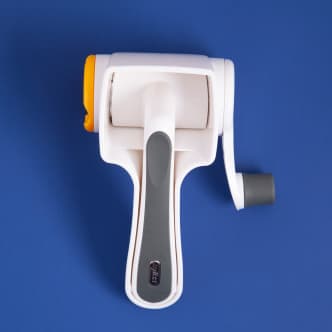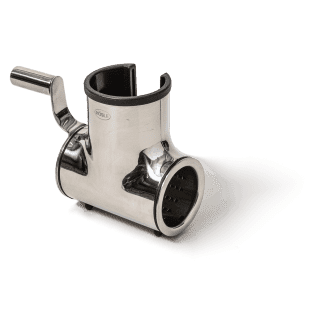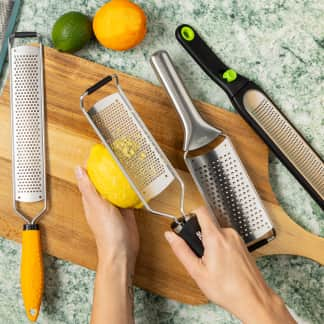Rotary graters purportedly make it easier and faster to grate hard cheeses such as Parmesan and Pecorino Romano. Some models come with additional inserts that allow you to grate or slice other foods more coarsely as well. To use a rotary grater, you insert the food you want to grate into the hopper and close the lid. With one hand, you press down on the lid so that the food is forced against a rotating drum studded with sharp teeth; with the other hand, you turn a crank, rotating the drum and grating the food. Since we last tested these gadgets, many of the models we examined have been discontinued or redesigned. And, dubious of tools that perform only a few tasks, we wanted to know if we still even liked rotary graters at all. So we tested six models, priced from about $11 to about $55, using them to grate different amounts of Parmesan (1, 2, 4, and 6 ounces)—the food we’d be most likely to grate in a rotary grater.
Rotary Graters Are Safe And Efficient And Grate Cheese Quickly
As it turned out, we liked the rotary graters a lot. Anyone who’s ever accidentally cut their fingers on a rasp-style grater knows how painful the experience can be. Rotary graters, on the other hand, make it nearly impossible to injure yourself—because the food is completely enclosed inside the hopper, your fingers never come anywhere near the sharp teeth of the drum. This clever design also means that rotary graters are safe for even children to use. And these graters let you grate Parmesan cheese down very close to the rind without fearing for your hands, so that you can get more out of every piece you buy.
We were also impressed by how well all the rotary graters performed. Each did a good job of finely grating mounds of Parmesan—and in much less time than our favorite rasp-style grater, which is what we’d ordinarily use for the task. On average, the rotary graters took about half a minute to finely grate an ounce of Parmesan; the rasp-style grater took more than twice that, at about 1 minute and 20 seconds.

Hopper Dimensions And Shred Size Help Determine Speed
Still, a few features made certain graters faster to use than others. The dimensions of the grater’s hopper were critical. The bigger the hopper, the bigger the piece of cheese we could fit in it, speeding up the grating process and requiring us to reload less frequently when grating larger amounts of cheese. The dimensions of the hopper’s bottom opening were particularly important, since they determined how much cheese made contact with the teeth on the rotating drum; here again, larger openings allowed for quicker grating. Bigger hoppers had another advantage: They were easier to load. Smaller hoppers required us to fuss more to whittle chunks of Parmesan down to a size that would fit inside.
The speed of each model also depended on how thickly it grated the cheese. Models that produced slightly thicker Parmesan shreds grated them more quickly than models that produced finer shreds, simply because they were shaving off more cheese with each rotation of the drum. Ultimately, we didn’t have a strong preference where the thickness of the cheese itself was concerned, though, since all the models grated the cheese finely enough to melt evenly into sauces such as the one in our Fettuccine with Butter and Cheese recipe.
A Good Grip Is Important
Performance and speed aside, some of the models were simply easier to use than others. Three had a design similar to that of a potato ricer, with a lever-like handle extending toward a lid that sits on top of the cheese in the hopper. Within this style, however, we found that handles made purely of slick plastic were more slippery to hold than handles featuring rubbery grips; those slick plastic-only handles also felt flimsier and occasionally made worrisome cracking noises when we squeezed them. (None broke during testing.)
The other models all had different designs—and different problems as a result. One grater required us to stretch our hands uncomfortably around both the hopper and drum to press down on the lid and get the cheese to make contact with the grating surface. And because both this model and another had lids that were firmly attached to the top of the hopper, there was a limit to how tall each piece of cheese could be, requiring us to carefully trim the pieces not only for their length and width, but also for their height. We much preferred the potato ricer–style models, as their lids were attached to their handles, not to the hopper; with these models, we could fit cheese of nearly any height into the hopper, swing the lid down, and get to grating.
We Prefer Smaller, More Portable Graters
Another grater had to be anchored to the table in order to be used, but its locking mechanism didn’t always work for us, so we sometimes had to fight with it to keep it stable enough to grate the cheese. Since this stationary grater sat upright, much of the cheese stayed put inside the rotating drum after it was grated, requiring us to tip the grater over or use a spoon to extract it. Worse, at about the size of a meat grinder, it was the largest of the models we tested; we much preferred the smaller profile and portability of the handheld models, which makes them easy to store and pass around the table at mealtimes.


Flexible Construction Makes Some Models Ambidextrous
We were surprised to find that not all graters were made for all users. Some models require you to install the crank on the right side of the rotating drum, a position that’s awkward for lefties, who had to contort their hands to use these models properly. We preferred ambidextrous models that could be assembled with the crank on the right or the left side of the rotating drum so that they could be used by both righties and lefties.
Durability Matters
Durability was also a concern. Some of the graters were built less solidly than others. While most were able to grate many ounces of cheese with no issue, the thin plastic struts that supported one model’s drum insert snapped off while grating a small, ½-ounce chunk of cheese at the end of testing; the entire grater was useless afterward. For obvious reasons, we preferred models that were more durable and would last a long time.
Cleanup Is A Pain
One reason you might want to stick with a rasp-style grater? Cleanup. Rotary graters just have more parts than the simple rasp-style grater and are thus a bit more of a pain to clean. During extended use, every one of those parts will get greasy or collect crumbled bits of cheese. All the models are dishwasher-safe, or have at least some dishwasher-safe parts, but if you don’t have a dishwasher, you’ll need to detail these graters carefully with a brush to extricate all the cheese.

The Best Rotary Grater: The Zyliss Classic Cheese Grater
We think that the Zyliss Classic Cheese Grater is the best option. Compact, but with a relatively large hopper that accommodated good-size pieces of cheese, it consistently grated cheese faster than any other model. Its plastic handle has rubbery grips that make it particularly easy to hold, and its crank can be installed on either side of the drum, so both righties and lefties can use it. If you grate a lot of hard cheese at home, we think you might really appreciate having one of these handy gadgets. As a bonus, we found that it’s also good at grating chocolate.
- Large hopper for holding and grating big pieces of cheese more quickly
- Rubbery insets on handle for comfortable grip
- Ambidextrous construction
- Small and portable for easy storage and tableside use
- Test 6 models, priced from about $11 to about $55
- Grate different amounts of Parmesan
- Wash according to manufacturers' instructions 5 times
- Grate chocolate (winner only)













